| Pages:
1
2
3
4 |
Sulaiman
International Hazard
    
Posts: 3779
Registered: 8-2-2015
Member Is Offline
|
|
Ether and flames is a poor combination choice
but I do not intend heating the ether,
just using a little more than necessary to dissolve any AuCl3 in the rbf,
then transfer to a test tube for slow evaporation.
A little ether compared to the litres of chlorine gas may be so dull that I'll fall asleep 
(yes, I've watched YT ether fire videos, and deliberately burned it to familiarise myself with the hazard)
Ethanol seems only a little safer,
because possibly due to assumed familiarity,
a casual approach may be more hazardous.
Anyway, I have none, and a covenant on my property means I shall not be making any.
The RBF with the gold and a fresh charge of chlorine gas, left to cook at 232C bath temperature
(nothing special about this temperature other than it seems to be working, and more variables complicate observations)
From the pattern of gold/AuCln surrounded by about 1cm of 'clean' glass (coinciding with the contact area of the sand bath)
then a ring of red/brown condensate,
then tiny yellow monoclinic-looking crystals
I assume that the gold is too hot for a 'simple' reaction,
but hopefuly enough yellow and red stuff will collect for me to have a go at analysing.
A poor photo
[Edited on 5-6-2016 by Sulaiman]
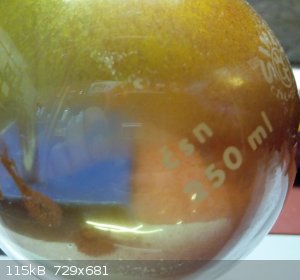
[Edited on 5-6-2016 by Sulaiman]
|
|
|
CRUSTY
Hazard to Others
  
Posts: 139
Registered: 5-6-2016
Location: Nearby
Member Is Offline
Mood: High-Order
|
|
You could always play around with some ring substitutions, ie chlorination of benzene and its derivatives, which would both use the FeCl3
mentioned in some previous replies as a catalyst and the raw chlorine gas to perform the substitution with. You could also, although it's not a really
pleasant product, attempt to synthesize thionyl chloride if you're feeling daring (REL is 1 ppm).
|
|
|
Sulaiman
International Hazard
    
Posts: 3779
Registered: 8-2-2015
Member Is Offline
|
|
The Dragon is bleeding ... First Blood
After 66 hours at around 232 C,
enough (presumed) AuCl3 has formed to look interesting ...
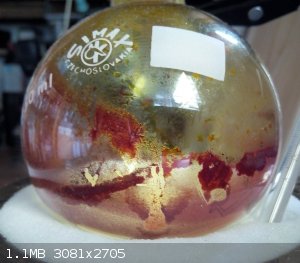
It seems that I chose the wrong experiment to do a slightly delayed running commentary,
my AuCl3 synthesis updates were a little optimistic regarding time-to-results ...
Clearly Alchemists were patient folk !
I have now reduced the bath temperature to around 210 C ......
|
|
|
aga
Forum Drunkard
    
Posts: 7030
Registered: 25-3-2014
Member Is Offline
|
|
66 hours !
Wow. That's a lot of firewood.
|
|
|
careysub
International Hazard
    
Posts: 1339
Registered: 4-8-2014
Location: Coastal Sage Scrub Biome
Member Is Offline
Mood: Lowest quantum state
|
|
Quote: Originally posted by aga  | I've decided to go ahead and copy Sulaiman's experiment.
Naturally, as an amateur, things are never so simple as 'pick up a vial of powdered gold' etc. |
In the future, anyone wanting to get gold fines should look at buying "placer gold" on-line. There are a fair number of people who pan (or sluice box)
for gold as a money-making pasttime and recover fine powder so it is always available.
|
|
|
Sulaiman
International Hazard
    
Posts: 3779
Registered: 8-2-2015
Member Is Offline
|
|
After adjusting the sand bath temperature to c 210 C
I went to check that the temperature had stabilised
my solder pot control must be faulty because the temp. was off the end of my 250C thermometer,
time to repair the solder pot .....
So after the rbf with gold + product cooled down
I used diethyl ether to dissolve the product
in a small test tube two layers formed,
a deep red at the bottom and yellow at the top .... hooray !
after a couple of minutes the red layer at the bottom slowly changed to orange, like this
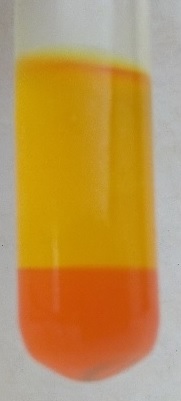
          
|
|
|
aga
Forum Drunkard
    
Posts: 7030
Registered: 25-3-2014
Member Is Offline
|
|
Well, you chlorinated the gold and got it out of the pot, which is an achievement !
Water in the ether maybe ?
|
|
|
j_sum1
Administrator
       
Posts: 6372
Registered: 4-10-2014
Location: At home
Member Is Offline
Mood: Most of the ducks are in a row
|
|
I too would like to try this one. (In a few months when my lab is back together.)
My gold source is going to be leaf. And I think I will attempt a setup where I keep the product on the glass. Perhaps a test tube or microscope
slide in a stream of chlorine.
The colour is seriously cool. And there is a bit of alchemy intrigue to this whole process.
|
|
|
Sulaiman
International Hazard
    
Posts: 3779
Registered: 8-2-2015
Member Is Offline
|
|
Now that a couple of hours since my dissapointment have passed,
and I've had something to eat and drink after the sun has set,
I'm not quite so upset 
Back to the drawing board (what term do chemists use ?);
I will see what I can recover from the 'product'.
I did not check for water in my ether 
I am expecting a sodium extruder soon so I'll test for too much water/violence,
then add a few sodium worms to dry it.
On the assumption that the anhydrousnes of the AuCl3 is lost,
I'm going to re-refine all ( c1g ) of my gold to gold dust ready for the next attempt,
then my setup needs modifying;
I need ideas on how to continuously expose the maximim area of hot gold to the chlorine gas.
All I can think of at the moment is a small stainless steel propeller on a long shaft.
I do not want to generate a continuous stream of chlorine gas
due to the problem of capture.
(my chlorine generator cannot provide enough pressure for a bubbler, and a lot of gas would be required for agitation)
Would the earlier suggestion by aga of a stir bar work?
(I am going to add proper temperature control to my solder pot, so adding spinning magnets may be on the list)
P.S. using 20g TCCA and an excess (30ml) of 18% HCl requires only a small reaction vessel,
my 1l vessel holds too much chlorine for later disposal.
(just flushing 1l of chlorine gas out of the flask with water turned the brass water tap black and pink !)
UPDATE: after c70% of the ether has evaporated, the 'product' looks incredibly like HAuCl4 aqueous solution.
Left = HAuCl4 Right = 'product' in ether
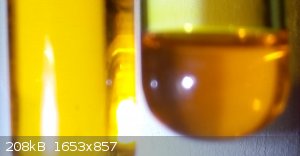
I'll see what is left in the test tube after complete evaporation ......
EDIT: tested my diethyl ether with a small piece of sodium ... DRY.
There should have been negligible H2O in the rbf as it was exposed to air only briefly whilst cooling and the chlorine gas is dry,
so I do not know what happened here.
[Edited on 8-6-2016 by Sulaiman]
|
|
|
Richard3050
Harmless

Posts: 17
Registered: 20-3-2016
Member Is Offline
Mood: No Mood
|
|
If you have any sodium metal you can experience the very exothermic production of salt.
"Science knowledge only adds to the excitement... I don't understand how it subtracts."
|
|
|
chemrox
International Hazard
    
Posts: 2961
Registered: 18-1-2007
Location: UTM
Member Is Offline
Mood: LaGrangian
|
|
Has anyone mentioned choral hydrate? Cl2 EtOH H2O ..?
"When you let the dumbasses vote you end up with populism followed by autocracy and getting back is a bitch." Plato (sort of)
|
|
|
aga
Forum Drunkard
    
Posts: 7030
Registered: 25-3-2014
Member Is Offline
|
|
Not knowing what happened is all part of the Fun !
You know for certain that Something happened, so it's a job for the experimenter in you.
The gas balloon thing worked pretty well when the S2Cl2 was done, so that may be a way to reduce the Cl2 required.
Having a small stirbar in there so you can 'mess' with the reactants is not only fun/time absorbing, it does allow you to jiggle the particles about
to expose fresh reactive surfaces.
Given the small scale, i suspect having smaller tube-like apparatus will be helpful, although i have no experience with this reaction, so do not know
for sure.
Time to stop guessing and actually try this myself so we can compare notes.
One cock-up at a time please.
Last time i tried for chloral hydrate (i.e. second time) kinda showed that the presence of any water does not give chloral hydrate, rather some
dissolved mess of products, which maybe includes a bit of chloral hydrate.
As per Vogel, the aim is to chlorinate Dry ethanol to precipitate chloral alcoholate/trichloroacetaldehyde/2,2,2-trichloro-1-ethoxyethanol then
dehydrate that with conc sulphuric to make chloral, then add a stoichiometic amount water to the dry chloral to get actual chloral hydrate.
Dumping damp chlorine into a pot of wet ethanol doesn't seem to work : it didn't when i tried it.
[Edited on 8-6-2016 by aga]
|
|
|
aga
Forum Drunkard
    
Posts: 7030
Registered: 25-3-2014
Member Is Offline
|
|
Turn Gold to Rust !
Despite a poor extractor fan in my 'hood, today i just had to try Sulaiman's Dragon's Blood synth (Au2Cl6)
Bodging together bits of glassware gave this :-
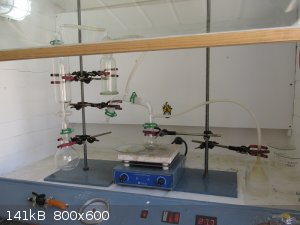
Left-to-right there's the standard len-chlorine generator, DCCA in my case, with the gas take-off directly from the top of a pressure-equalised
addition funnel.
Next is a (broken/repaired) gas wash bottle with some conc H2SO4 in it.
The chlorine feed then goes to a couple of vac adapters, as there was nothing else available to get the gas into the 25ml RBF where the gold is
sitting.
This RBF has a stirbar and sits 10mm above the hotplate (i.e. 'airbath').
The addition funnel was charged with 100ml 20% HCl, 30g DCCA put in the chlorine generator, but not attached yet.
Heating and stirring were started and a very slight vacuum started to pull dry air thru the apparatus for 5 minutes.
Then the vac was disconnected and an NaOH inverted funnel trap fitted to catch as much 'waste' chlorine gas as possible.
The DCCA vessel was then attached and the HCl drip-feed started.
Pretty soon we have chlorine in all the glassware :
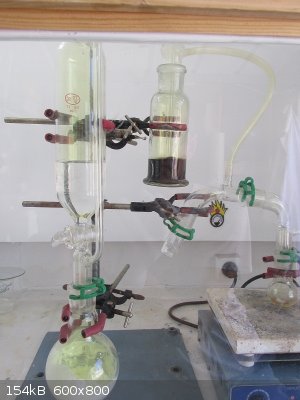
After around 5 minutes there was a noticeable colour change :
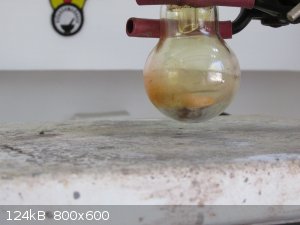
After 15 minutes the precious gold resembled Rust !
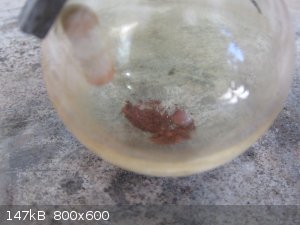
The experiement was stopped after 1 hour, by which time a rich redness was apparent in the reaction vessel :
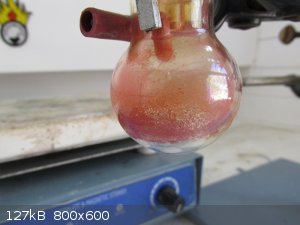
If this is actually gold (III) chloride, what do i do with it ?
|
|
|
blogfast25
International Hazard
    
Posts: 10562
Registered: 3-2-2008
Location: Neverland
Member Is Offline
Mood: No Mood
|
|
Try and dissolve it in 12 M HCl, that should give an acidic AuCl4-(aq) solution.
Then carefully neutralise to pH > 4 and add a reducing agent like sodium metabisulphite. The Au should drop out as powder.
Nice set up, BTW.
[Edited on 11-6-2016 by blogfast25]
|
|
|
aga
Forum Drunkard
    
Posts: 7030
Registered: 25-3-2014
Member Is Offline
|
|
DOH !
So all this is just to get more finely divided gold particles for the next run !
|
|
|
aga
Forum Drunkard
    
Posts: 7030
Registered: 25-3-2014
Member Is Offline
|
|
Wait a sec - does that mean you stuffed some chlorine into the reaction vessel, then Stopped the chlorine flow, then left it overnight ?
|
|
|
aga
Forum Drunkard
    
Posts: 7030
Registered: 25-3-2014
Member Is Offline
|
|
The remains in the reaction pot were washed out with water, then filtered. The solid Gold remains were weighed.
It didn't do very well : only 0.08g of the Au reacted in 60 minutes.
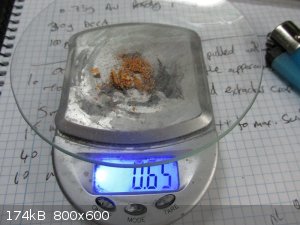
What to do ? Chlorinate other stuff of course !
Al foil was a bit boring, doing pretty much nothing even with heating.
Sn turnings ? Before:
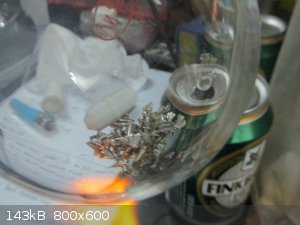
After a few minutes :
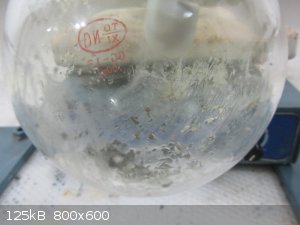
Amazingly a couple of Orange Sparks were seen in the reaction pot whilst jiggling the stirbar.
Clearly one of the errors here is that not enough Tin was used and it was not dried thoroughly.
How do you get the tin chloride out of the pot if it is just a film of white stuff on glass ?
To round it off, back to a familiar chlorination : Sulphur
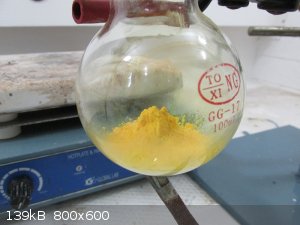 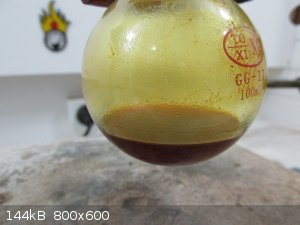
Maybe best to use that S2Cl2 up quickly, and make factice again tomorrow with linseed oil.
Certainly not going to risk losing more glassware trying to store a reagent i do not really need.
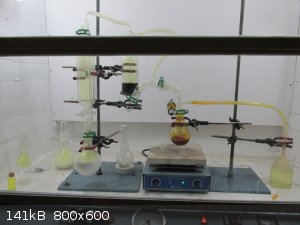
The gas generator and wash pipes have become almost white due to attack by chlorine.
The pipe on the right has been attacked by disulphur dichloride vapours.
This is why the tubing in this setup should be considered a 'consumable' : it will be discarded when the apparatus is disassembled, as it is well and
truly knackered.
|
|
|
Sulaiman
International Hazard
    
Posts: 3779
Registered: 8-2-2015
Member Is Offline
|
|
"How do you get the tin chloride out of the pot if it is just a film of white stuff on glass ?"
This is exactly what I am considering for the anhydrous AuCl3,
I think that some creativity in the 'inert atmosphere' area is required,
for the dry chlorine + gold (or tin etc.) , the dense chlorine protects the product,
until you want to extract it ...
I'm flat on my back at the moment so it is great to see your progress ... SM rules!
P.S. Love the hood ... I hope you enjoy using it.
[Edited on 11-6-2016 by Sulaiman]
|
|
|
aga
Forum Drunkard
    
Posts: 7030
Registered: 25-3-2014
Member Is Offline
|
|
Sorry to hear about your horizontalism.
Glad to bring at least a modicum of succour with my random chemistrations.
Edit:
'Inert' is a relative term.
100% Chlorine atmosphere works quite well in this case.
My question is more about how to get the stuff off the glass in any useful quantity.
Maybe Gold Chloride dissolves in disulphur dichloride ...
.. then again, how would they be separable ?
Questions questions.
[Edited on 11-6-2016 by aga]
|
|
|
Sulaiman
International Hazard
    
Posts: 3779
Registered: 8-2-2015
Member Is Offline
|
|
I have CHCl3 which may be worth a try, even if it gets chlorinated to CCl4 it may not be a problem ?
I am working on the assumption that anhydrous AuCl3 crystals can be grown .... that may be like trying to grow P205
crystals 
I like the gold foil idea, maximum surface area exposed,
(I have read many accounts of fake gold leaf via eBay so care required)
aga; how effective do you think your chlorine trap was?
|
|
|
aga
Forum Drunkard
    
Posts: 7030
Registered: 25-3-2014
Member Is Offline
|
|
The clorine trap works very well if you can time the chlorine production right, meaning no gas bubbles escape from the trap.
I have never managed to get it that precise, so some chlorine always escapes - more than enough to warrant a fume hood.
Perhaps a much bigger trap (e.g. a bucket and very large funnel) would give more leeway with the timing, although a significant amount of chlorine
escapes anyway when you dismantle the apparatus.
|
|
|
aga
Forum Drunkard
    
Posts: 7030
Registered: 25-3-2014
Member Is Offline
|
|
Maybe best to use that S2Cl2 up quickly ...
No, best not to make S2Cl2 at all.
I'd forgotten how reactive it is and how much it stinks.
A small qty was put into a tiny dram vial with a cork stopper, the foolish idea being to seal it with wax.
By the time the wax melted, the cork had been almost totally destroyed.
God awful job to clean up the mess - gas mask aboslutely Essential.
|
|
|
NEMO-Chemistry
International Hazard
    
Posts: 1559
Registered: 29-5-2016
Location: UK
Member Is Offline
Mood: No Mood
|
|
Quote: Originally posted by aga  | No, best not to make S2Cl2 at all.
I'd forgotten how reactive it is and how much it stinks.
A small qty was put into a tiny dram vial with a cork stopper, the foolish idea being to seal it with wax.
By the time the wax melted, the cork had been almost totally destroyed.
God awful job to clean up the mess - gas mask aboslutely Essential. |
What mask do you use? i would appreciate a link if you have one. You seem to mess with some nasty things in a shed! But your alive, so i am figuring
it might be worth getting a mask like yours  . .
Love the shed stuff! Chlorine i would like to work with, some of the other things you do i enjoy reading about but dont fancy doing myself  . .
|
|
|
aga
Forum Drunkard
    
Posts: 7030
Registered: 25-3-2014
Member Is Offline
|
|
Dunno what make the mask is - some generic thing with two replaceable A1 filters, which both appear to have expired in Nov 2015 ...
Think i'll get one of those full-face masks because the sulphur chloride fumes sting the eyes quite a bit.
|
|
|
NEMO-Chemistry
International Hazard
    
Posts: 1559
Registered: 29-5-2016
Location: UK
Member Is Offline
Mood: No Mood
|
|
Ok dopey question alert!!
Is A1 a reference to the size of molecule they filter? I just kind of figure if Mol sieves for water are known as A3 then maybe the filters for masks
are numbered in a similar way?
Is the mask one of those with the cartridges on? sorry for all the questions but i dont have fume cupboard yet and a mask would be useful anyway, i am
a bit of a chicken with most chemicals  . .
|
|
|
| Pages:
1
2
3
4 |